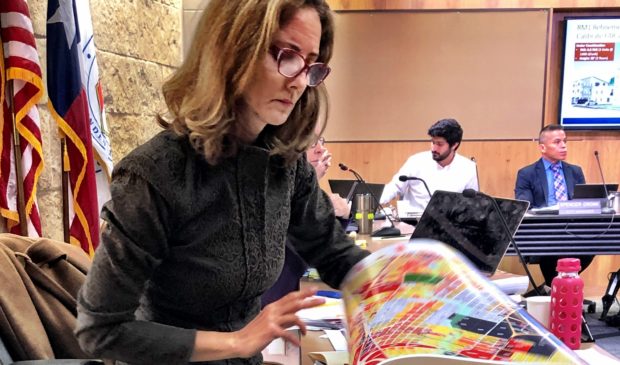Draft Land Development Code approved on first reading
Thursday, December 12, 2019 by
Ryan Thornton Wrapping up a three-day effort, City Council approved the draft Land Development Code text and map on first reading in a 7-4 vote Wednesday afternoon.
In accordance with Council direction, the code revision team will now work to compile and publish the revised code text and map as quickly as possible to allow time for review and comment leading up to second reading in early February.
“With every day, we’re losing the benefit the code rewrite can provide on environment and climate mitigation; we’re losing the ability to move forward on mobility choices and safety and congestion; we’re watching the displacement of vulnerable people in communities; we’re losing affordable housing stock … we’re losing potential housing supply on lots that we’ll never recover; we’re not reducing flood risk, and we’re not increasing equity in the ways that a code rewrite can,” Mayor Steve Adler said prior to the vote.
The revision team will now prepare the first of three zoning maps for release with the revised text in late January. After second reading, staffers will compile those additional changes into a second map and create a map document with a spreadsheet that will serve as the basis for the final map to be approved upon final reading at the end of March.
Most mapping issues are going to be taken up at second reading, but the mapping of special zoning districts and depth of transition zones in house-scale neighborhoods were again major points of disagreement Wednesday.
With Neighborhood Conservation Combining Districts in mind, Council Member Natasha Harper-Madison brought direction to an amendment from Council Member Kathie Tovo that was intended to protect lots with existing “missing middle” housing from redevelopment by zoning them according to current use. Also concerned about losing missing middle housing, Harper-Madison added language to clarify that the zoning would apply citywide, including in districts with special zoning privileges.
Despite claiming that all of the relevant missing middle parcels were already zoned according to that use, Tovo said she wasn’t comfortable with the potential implications of the new language. Council Member Alison Alter noted that this seemed to have the opposite intention of protecting missing middle from being zoned to a lower use, not a higher use, warning that dictating zoning in special districts could be opening a Pandora’s box that Council had decided to keep shut. Tovo wanted to table the amendment, but Council Member Greg Casar moved to pass the clarification to add “citywide” to Tovo’s original language. The motion passed.
More contention arose over core neighborhoods with an amendment by Casar to refine downtown mapping and regulations. The neighborhood in question was Judges Hill in the northwest corner of downtown, which Casar wished to protect from the affordable housing bonus proposed by the Planning Commission for commercial core lots. Casar carried forward the Planning Commission’s recommendation to allow unlimited height under the bonus program for those lots, but clarified that staff should determine the appropriate height allowance under the bonus in northwest downtown, an area that still has many residential house-scale properties.
Here, too, Tovo took issue, stating that the community that has been involved with the Downtown Austin Plan has already crafted many of its own solutions regarding height and transitions into the house-scale blocks.
In another part of the amendment, Casar asked the code revision team to consider whether there could be more participation in the affordable housing bonus program if certain commercial center tracts downtown were rezoned to Downtown Core. Erica Leak of the Neighborhood Housing and Community Development Department said she didn’t see how that could be the case. Casar admitted the idea had come from stakeholders and could be rejected at the team’s discretion.
Tovo took issue with Casar proposing a complicated amendment involving her district without consulting her. Harper-Madison argued in favor of trying to modernize downtown’s aging zoning plan. Greg Dutton with the Planning and Zoning Department agreed that the 2011 Downtown Austin Plan could use an update, but said it would be better if that were part of a holistic vision. Casar’s amendment passed.
As expected, Tovo brought back several amendments to address and limit the mapping of transition zones. Showing a number of examples where transition areas extend further than the five-lot maximum Council had proposed in May, Tovo said there are multiple neighborhoods in District 9 where these missing middle zones make up almost, if not more than 50 percent of the lots.
Tovo proposed an amendment to make transition areas on the Transportation Priority Network in residential areas more shallow than those along major corridors. She also brought an amendment that would limit missing middle zones Residential Multifamily 1 and Residential 4 citywide to make up no more than 20 percent of a neighborhood. Having seen her examples, several Council members said they would consider these problem areas for potential amendments at second reading.
Alter pushed for a solution, stating that all of the “angst” over transition zones is related to a relatively small number of units compared to the overall capacity being added. With other ways to add capacity along corridors, Alter asked her colleagues to consider whether it was worth creating trust issues with all of those upset over the transition zones in order to get fewer than 20,000 units.
Harper-Madison and Mayor Pro Tem Delia Garza both expressed sympathy with Tovo’s intent, but weren’t comfortable with the blanket 20 percent cap on missing middle zones. Those amendments failed.
Noting that some of her constituents are actually pushing for more entitlements for their properties, Harper-Madison said she would need to give the proposals more thought. After voting, she read a text message she’d received on the dais from an 87-year-old constituent who said, “Honey, don’t you let them downzone me!” She meant, Harper-Madison explained, to allow the rezoning of her property, because her family could benefit from the entitlements.
With a motion from Casar, Council approved the amended code. Council members Leslie Pool, Ann Kitchen, Tovo and Alter voted no.
Council Member Pio Renteria and Garza both took a moment to express gratitude that the city’s 10-1 Council is finally allowing the economic and racial progress it has put off for decades.
“We need to integrate this city, and the only way we’re going to do it is through density and relaxing our zoning so that we can create more housing so that everyone can live anywhere they want and not have an exclusive neighborhood off by themselves,” Renteria said.
Photo: Council Member Kathie Tovo studying maps. Photo by Jo Clifton.
The Austin Monitor’s work is made possible by donations from the community. Though our reporting covers donors from time to time, we are careful to keep business and editorial efforts separate while maintaining transparency. A complete list of donors is available here, and our code of ethics is explained here.
You're a community leader
And we’re honored you look to us for serious, in-depth news. You know a strong community needs local and dedicated watchdog reporting. We’re here for you and that won’t change. Now will you take the powerful next step and support our nonprofit news organization?




